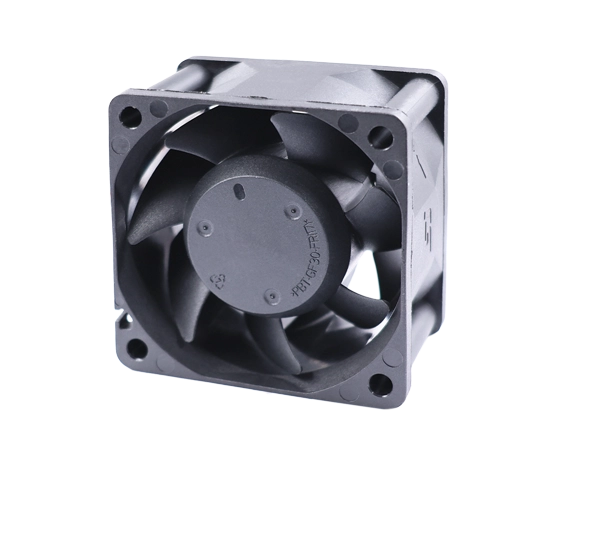In the rapidly evolving world of high-performance computing (HPC), server infrastructure has become more complex and power-hungry. The efficiency of cooling systems in these environments is a crucial factor in maintaining system stability, reducing energy consumption, and ensuring the longevity of hardware components. One such cooling solution that has gained significant traction is the DC axial fan. Known for its energy efficiency, precise control, and performance reliability, the DC axial fan is a game-changer in the server industry, playing an indispensable role in maintaining optimal operational conditions.

Technology of DC Axial Fans
DC axial fans are a specialized type of fan designed to provide efficient airflow for various industrial applications. The term "axial" refers to the direction of airflow relative to the axis of the fan, meaning air moves in a straight line parallel to the fan's rotation. This technology is especially advantageous in environments that require consistent, directed airflow, such as server rooms, data centers, and high-density computing environments.
At the core of DC axial fans is a direct current (DC) motor, which differentiates them from their AC-powered counterparts. Unlike traditional AC fans, DC axial fans are powered by a DC power supply, allowing for more precise control over fan speed and energy consumption. These features make DC axial fans highly suited for applications that demand both energy efficiency and fine-tuned control over cooling performance, such as servers.
Why DC Axial Fans Are Essential for Server Cooling Systems
The performance and reliability of servers depend heavily on their operating temperature. Overheating can lead to hardware failure, reduced performance, or even data loss. As a result, maintaining an optimal temperature is critical to ensuring the smooth functioning of server systems.
1. Efficient Heat Dissipation
Servers generate significant amounts of heat due to the dense packing of processing units, storage devices, and other components. In a typical server, processors can reach temperatures well above 80°C (176°F), requiring effective cooling solutions to prevent overheating. DC axial fans play a key role in heat dissipation by providing high-volume airflow to carry heat away from critical components, such as CPUs, GPUs, and power supplies. The use of DC motors in these fans offers the advantage of higher efficiency compared to AC motors, allowing for quieter and more reliable operation while delivering the necessary cooling power. This is particularly important in server environments where noise reduction is also a priority.
2. High-Speed Performance with Precision Control
DC axial fans provide precise control over fan speed, which allows for dynamic adjustment based on the server’s cooling requirements. Unlike traditional AC axial fans that operate at a constant speed, DC axial fans can be adjusted based on thermal conditions within the server chassis. This variability enables the fan to increase airflow when cooling demands rise, and reduce speed when thermal load decreases, optimizing energy consumption. This adaptive performance is particularly beneficial in server rooms that run 24/7, where temperature fluctuations can occur based on workload and usage. The ability to scale fan speed accordingly ensures that servers remain at optimal temperatures without overcooling, which can waste energy.
3. Space Efficiency in Compact Designs
As data centers and server rooms continue to grow in complexity, the need for compact and efficient cooling solutions has never been more apparent. DC axial fans, due to their slim profiles and high-efficiency motors, are ideal for environments where space is at a premium. In many modern server designs, particularly blade servers and rack-mounted units, there is limited space available for cooling components. DC axial fans, with their ability to generate powerful airflow in compact packages, are a perfect match for these high-density setups. Their space-efficient design helps maximize cooling capabilities while minimizing the footprint of the cooling system, which is essential for high-density server environments.
4. Energy Efficiency and Sustainability
Energy efficiency is a growing concern within the server industry. Data centers are notorious for their high energy consumption, and cooling systems account for a large portion of this usage. DC axial fans stand out in this regard because of their ability to provide high airflow while consuming significantly less power than traditional AC-powered fans. This results in lower operational costs and reduced carbon footprints for data centers. In fact, the use of DC axial fans in server cooling systems can lead to substantial energy savings over time. With their variable speed capabilities, DC axial fans adjust their power usage in real-time, ensuring that cooling power is only used when necessary, further enhancing energy efficiency.
5. Noise Reduction
While not often discussed, noise is a significant concern in server environments. Traditional cooling fans, particularly those powered by AC motors, can generate a considerable amount of noise, which may be problematic in environments where noise levels need to be controlled. DC axial fans, on the other hand, are known for their quieter operation. This is due to the smoother control over motor speed and the inherently quieter nature of DC motors. In data centers or server rooms where noise levels can be a concern, DC axial fans help create a more comfortable and less disruptive working environment.
In conclusion, DC axial fans have become an integral component of modern server cooling systems, offering significant benefits in terms of efficiency, precision, and performance. With their ability to provide targeted, adjustable airflow, DC axial fans help data centers maintain optimal temperature conditions while minimizing energy consumption and reducing noise. As the demand for high-performance computing continues to grow, the role of DC axial fans in server cooling systems will only become more important, ensuring the reliability, sustainability, and efficiency of the data-driven world.






